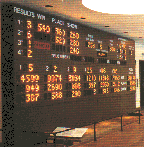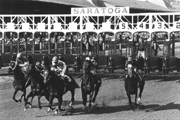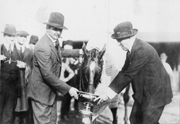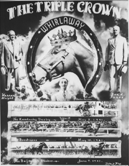The Twentieth Century and Beyond
The beginning of the twentieth century marked a low point for both English and American racing, as gambling and corruption took a firm hold on race tracks across both countries. In the United States, state governments responded with anti-gambling legislation which effectively closed most American race tracks by removing what had become the main incentive for attendance. With no bettors and little interest, breeders lost their market for Thoroughbreds and, devastated, were forced to export large quantities of bloodstock overseas. To alleviate a desperate situation, Churchill Downs officials began using French pari-mutuel boards in 1908. The boards created a legal and honest betting pool, where odds were determined solely by the amount of bets placed on each horse. State racing associations and governments gradually accepted the pari-mutuel, and it came to represent the rebirth of American racing. In England, the pari-mutuel appeared, but bookmakers also continued to ply their trade as officials sought other solutions.

Toteboard
The board displays race times, and results, and provides the current odds for each horse based on the amount of money bet.
Both racing and breeding were affected by the great wars of the twentieth
century. In England, racing was halted as unnecessary activities during
the first and second world wars. In the United States race tracks remained
open but found themselves dealing with the problems caused by wartime rations:
transportation was limited, excluding horses from faraway meetings, and
materials for building and repairing tracks and stables were stringently
restricted to war use. The post-war years of 1919 and 1945 to 1946 witnessed
amazing explosions of popular support for racing, as the euphoria of victory
and carefree spending took hold. Once again readily available, building
materials were put to good use in post-war years to build larger, more modern
grandstands and clubhouses on major race tracks.
At an ever-increasing rate, new technological advances found their way into racing and onto these updated tracks, helping to assure the continued integrity of the sport. In 1929, the mechanical starting gate eliminated delays and disputes caused by the traditional starting line or tape. Close races were no longer a problem with the advent of the photo-finish camera, which caught every finish on the indisputable medium of film. These and other advances in mid-century reassured fans of racing's honesty, and brought more and more people to the track. These changes meant new tasks for trainer and breeder as well, as they prepared their horses to deal with the new machines and practices of the track.

Starting Gate
A gate in action at Saratoga.
At the same time that England and the United States were modernizing
racing and race tracks, another trend was beginning that would, by the end
of the century, revolutionize the racing and breeding industries: internationalization.
Boundaries between countries began to fall, as more and more horses made
overseas journeys to compete, and rules of racing became standard all over
the world. New owners, from countries traditionally uninvolved with racing,
began spending large amounts on English and American bloodstock. And breeding,
too, became an industry without borders, with mares and stallions regularly
exported to provide a particular genetic cross.
Japan first imported American Thoroughbred stock in 1895, with a small shipment of only fourteen stallions and mares. Their fledgling breeding industry was completely devastated during the Second World War, but since then has grown steadily into one of the most prominent in the world. Racing, too, has gained an enthusiastic following throughout Japan, as hundreds of thousands of fans attend race meetings outside of Tokyo.
Another major contributor to late twentieth century racing and breeding is the royal family of oil-rich Dubai. After blowing into the American bloodstock market in the 1980s and paying millions for top colts, these Arab owners have produced and trained their own crop of successful racers. To provide a showcase for their own Thoroughbreds, as well as to welcome the best from around the world, Dubai has become the latest in a string of countries to begin annual races meant specifically for international fields of horses. The four million dollar Dubai World Cup will be held for the first time in the spring of 1996.
The Dubai Cup, as well as offering a purse large enough to attract the world's best horses, will provide conditions and regulations that are sympathetic to the habits and needs of Thoroughbred competitors from all countries. The Washington International, held at Laurel Race Track in Maryland, was the first race to attempt to accommodate foreign horses, and has been followed in the United States with the ten million dollar Breeders' Cup and Chicago's Arlington Million. France hosts the annual Arc de Triomphe for an international field, and the Canadian International Championship and Japan's Tokyo Cup also draw some of the world's best.
The search for the world's best racer is becoming more and more difficult. From self-contained breeding farms in the United States and Europe, breeding has become an enormous industry that consistently crosses international borders in a quest for the ideal mix of genetics that might produce an international champion. Stallions are exported from England to cover the mares at a Japanese farm, while a single Australian mare might be imported to the United States to be covered by a Secretariat descendant.
Racetracks, like breeders and owners, have been deeply affected by changes in the late twentieth century. Advanced communication technology has come to form a major part of the structure of the sport. Television coverage allowed millions of people access to important races, and the advent of off-track betting provided the chance to place bets on races across the country. Many tracks, too, have embraced the idea of the simulcast, where fans can watch and bet on an entire race day at a distant track while the local track is dark. These innovations have brought millions of people from all classes and all areas of the world together in racing. The proximity of the racetrack is no longer a factor, as long as a television or off-track betting parlor is within reach.
In this fast-paced environment which has transformed a sport defined by tradition into a vehicle of the twenty-first century, the Thoroughbred still retains the spotlight. It would not be inconceivable that a horse born in Ireland of American and English parents would race in five countries, be retired to stud in Japan, and produce offspring in Australia and Dubai. Yet even as bloodlines change, and the community around the Thoroughbred grows, the horse remains the same bundle of energy, glory, and power, and new champions have appeared that embody the same spirit and stubbornness of Man O' War and Eclipse. Spectacular Bid, Sea Hero, and Cigar each have taken their place, deservedly, among the great Thoroughbreds of all time.
The Champion
Man O' War, Secretariat, Cigar. Their performances stirred people to tears,
and fostered undying loyalty from their fans. What is it that marks certain
Thoroughbreds as true champions of the sport of horse racing? Of the 50,000
Thoroughbreds foaled each year, only three of five of them will ever win
a race (Flake). Of these winners, only a few will become household names.
Some of these true champions reveal themselves early, while some come into
their glory only as an older horse or at stud. Some make their name in one
astounding, come-from-behind victory, but others secure themselves a place
in history with a perfect racing record. Looking at individual champions,
it becomes clear that a Thoroughbred champion is a horse that has simply,
somehow, captured the spirit of the sport and the imagination of the racing
fan.
Arguably, the first champion English Thoroughbred was a chestnut named Eclipse.
Foaled in 1764 during a solar eclipse, Eclipse was the great-grandson of
the Darley Arabian. Eighteenth century racing in England was generally reserved
for horses of five or older, so at age five, Eclipse went into training.
In his first race, a match race of four-mile heats, Eclipse distanced his
competitors4, an event which coined
the phrase "Eclipse first, the rest nowhere".
From that point on, Eclipse won every race he entered, and, according to
legend, "was never whipped, spurred or headed. He became,
literally, matchless (Longrigg, 80)."

Man 'O War
The tired Man 'O War takes a sip of champagne from his trophy in the winners circle.
In the twentieth century, Man O' War was to become as big a legend as
was Eclipse. Known by most as "Big Red",
and by his groom as "the mostest hoss",
Man O' War got his name from his breeder August Belmont. When Belmont enlisted
in World War I at age 65, his proud wife named their new colt "My
Man O' War". When the colt was sold at auction, the name
stuck. Man O' War entered 21 races in his two year career, winning all but
one. Eight of his wins set records, as did his earnings of almost $250,000.
With this astounding record, Man O' War came to embody the "horsemen's
credo for judging greatness: "it isn't just what he did;
it's how he did it" (Bowen, 55)." At
his death, Man O' War was laid in state, and thousands appeared to mourn
a lost hero.

Whirlaway
The triple crown races, once joined as a series, became the ultimate test of a thoroughbred, and winners became the heros of the race track.
The Triple Crown series was created in the 1930s by linking the historic
Classic races: the Kentucky Derby, the Preakness Stakes, and the Belmont
Stakes. This series has produced several enduring champions over the course
of the twentieth century. In the minds of fans, owners, and trainers, the
Triple Crown has become the proving ground of the truly great champions.
Secretariat, also known as "Big Red",
won the series in 1973, the first winner in 25 years. He won the first two
legs of the Crown two and a half lengths ahead of his nearest rival, but
it was his finish in the Belmont Stakes, an amazing 31 lengths ahead, that
secured Secretariat his place in history.

Secretariat Plaque
Secretariat's Hall of Fame plaque describes his amazing record.

Regret
The victorious accepts the traditional blanket of roses in the winner's
circle at the Kentucky Derby.
Not every Thoroughbred hero has become immortal with an amazing win record.
Some have gained recognition with wins against all odds. The filly Regret
won the 1915 Kentucky Derby against a field of colts. That feat was not
repeated until 1980, with the victory of Genuine Risk. Some horses seem
to flourish on one particular track or in one area of the country. While
their race records are not stellar, they have captured the hearts of local
audiences and live as legends. Seabiscuit, an average horse in the Eastern
United States, was taken to California later in his career and became the
father of California racing. More recently, Saratoga fans have adopted Fourstardave
as their local champion. Although only average on other tracks, "Dave",
nicknamed the "Sultan of Saratoga",
has won at Saratoga every year for eight straight. When he retired in 1995,
a street in town was named for him.
Champions are sometimes remembered for their part in a great rivalry. These
matches between two brilliant racers go back as far as does horseracing.
In nineteenth century United States, matches between the North and the South,
with the best horse from each region competing, were extremely popular.
In 1841, the New Jersey bred Fashion and the Virginia born Boston met. Fashion,
the younger horse by four years, was known as "one of
the fleetest, gamest misses of the turf"(Longrigg, 213)
and had an unblemished record. Boston, also unbeatable, was nicknamed "Old
Whitenose". Boston came not from the city but from a card
game; his breeder lost him in a wager. Thousands of fans came to Camden,
New Jersey to see the two pitted against each other. Youth prevailed, and
Fashion won. Both horses are remembered not for their individual races but
for their rivalry with each other.

Affirmed vs. Alydar
In one of their blazing match-ups, the two horses race toward the finish side by side. This time, Affirmed races ahead of his rival to take the 1978 Preakness.